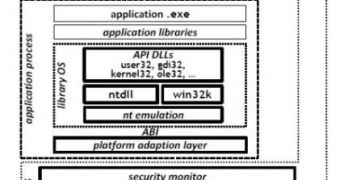Drawbridge is another non-Windows operating system project from Microsoft Research that can be added to the list already containing initiatives such as Singularity and Menlo. According to Ma-Config, the team behind Drawbridge is the same as the one that put together Singularity, under the leadership of Galen Hunt, Principal Researcher in the Microsoft Research Operating System Group.
Drawbridge is detailed in the “Rethinking the library OS from the top down” whitepaper which proposes a new strategy for the architecture of a library OS.
“The idea of the library OS is that the personality of the OS on which an application depends runs in the address space of the application,” reads an excerpt from the whitepaper’s abstract.
“A small, fixed set of abstractions connects the library OS to the host OS kernel, offering the promise of better system security and more rapid independent evolution of OS components.”
According to the documentation available, Drawbridge’s architecture is divided into three key areas, the Host OS, the Application Processes and the Shell.
It is this separation between Host OS, applications and Shell that contributes to increasing the security of the platform.
It appears that successful tests of Drawbridge have already been done, not only on Windows 7, also on its server counterpart Windows Server 2008 R2, the MinWin core, as well as on an early development milestone of Windows 8.
“We describe a working prototype of a Windows 7 library OS that runs the latest releases of major applications such as Microsoft Excel, PowerPoint, and Internet Explorer. We demonstrate that desktop sharing across independent, securely isolated, library OS instances can be achieved through the pragmatic reuse of net-working protocols,” reads another excerpt of the Drawbridge abstract.
What is important to underline is that Drawbridge is just a Microsoft Research prototype and might never be more than this.
Even though the whitepaper talks about the prototyping of a commercial operating system, this does not mean that Drawbridge will ever hit store shelves, or that any innovation created as a part of this project will end up being integrated into Windows, or any commercial product from Microsoft, for that matter.
Still, as the project demonstrates, Drawbridge is already capable of running Windows applications, since it supports some 14,000 Win32 APIs, which of course, is only a drop in the ocean of Windows application programming interfaces.

 14 DAY TRIAL //
14 DAY TRIAL //